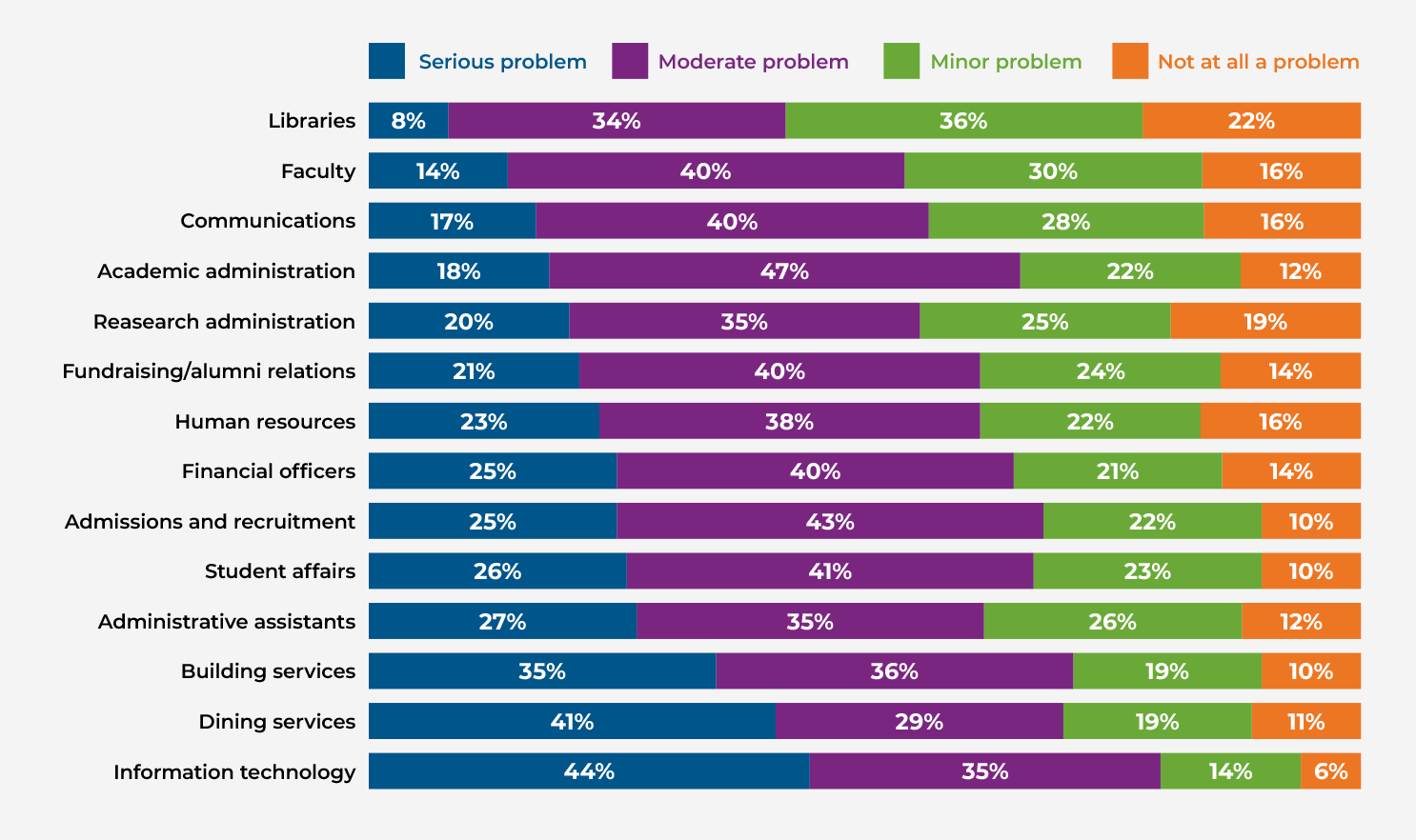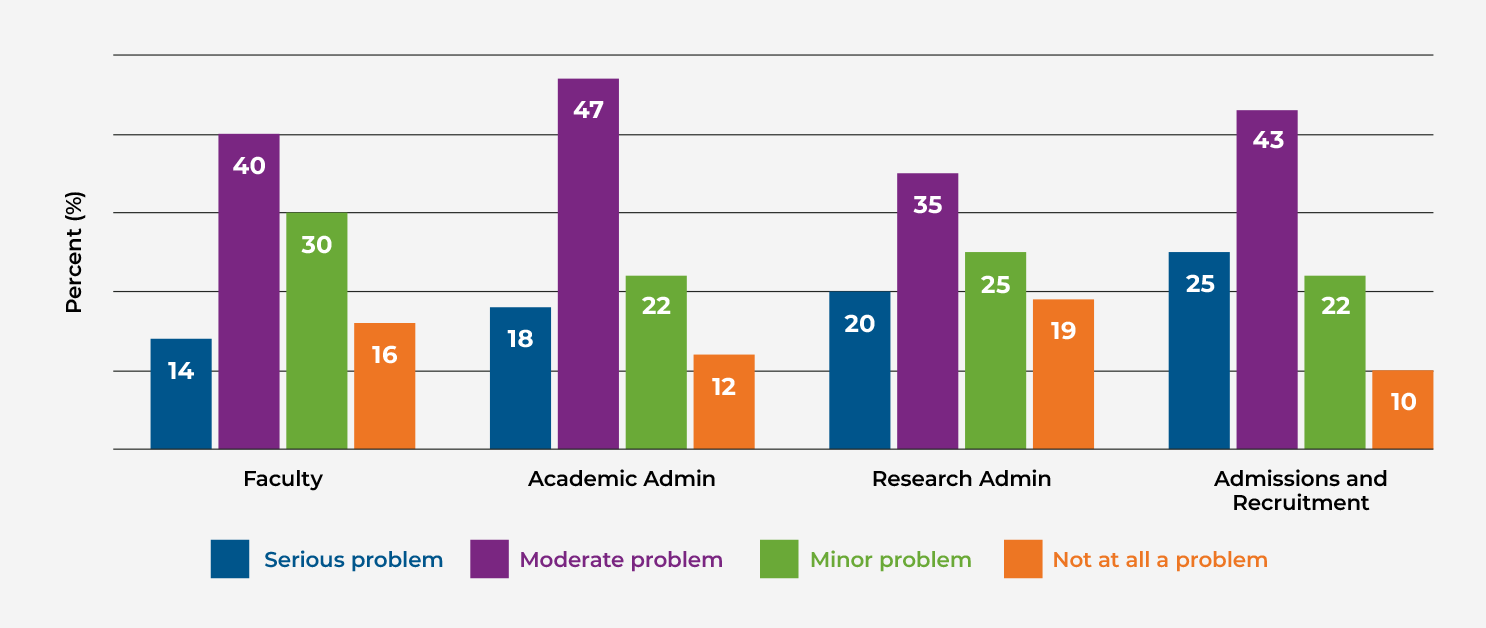What colleges and universities are doing to win the “war for talent”
The pandemic gave rise to what’s been called the “great resignation,” as record numbers of employees quit their jobs and made career changes. However, the labor force participation of Americans in their prime working years (25 to 54) has surged back to 2019 levels, and a recent survey found that more than 1 in 4 people who quit in the past few years regret their decision. An autumn 2022 study concluded that the higher education workforce has returned to roughly its pre-pandemic size.
Meanwhile, the rise of “quiet quitting” has many employees redefining boundaries and expectations on their terms. All this has led some observers to refer to this moment as the “Great Reshuffling,” as the talent market continues to shift in highly fluid and unpredictable ways.
Whatever you call it, we are experiencing a historically tight labor market. The U.S. economy has nearly twice as many job openings (11.5 million) as unemployed workers (6 million). In April 2021, Forbes Magazine predicted this coming challenge, declaring the dawning of the “war for talent.”
In the higher education sector, this comes at an already challenging time. There are economic pressures in the broader economy from record inflation to higher interest rates. Many universities continue to contend with historic enrollment declines and the largest drop in endowments since 2009. In addition, the sector faces headwinds in terms of public support. A recent poll by Public Agenda found that two-thirds of respondents said they see colleges as “stuck in the past” and not serving the needs of today’s students.
The higher education business model is under scrutiny and is evolving rapidly. It is a time when attracting and retaining the best talent is as critical now as it has ever been for colleges and universities.
“When I talk to colleagues around the country, there’s this clear sense that we are in a time of great challenge and opportunity,” said Rythee Lambert-Jones, assistant vice president for university human resources at the University of Maryland. “Every one of my colleagues understands that those schools who succeed will be those that win the competition for top talent.”
The Impact on Colleges and Universities
Succeeding in a time of “stable instability” requires a 360-degree view of finance, operational, and talent data. Higher education leaders are collaborating to respond to the challenges and retain talent while building a pipeline of people with the appropriate skills. Provosts and chief human resources officers (CHROs) are working hard to minimize the effect on the academic mission, shoring up faculty morale and evaluating approaches to the future work environment.
“There are few industries where talent plays a bigger role than in higher education,” said Kevin Molloy, senior higher education adviser at Workday. “Today, multiple factors are requiring increased focus and agility.”
A recent survey found that colleges and universities find it harder to attract and retain talent, have more open positions, and see fewer qualified applicants. Huron and The Chronicle of Higher Education collaborated on the national survey of higher education leaders, hiring managers, and administrators. The survey also found that universities emphasize increased recruitment flexibility and rely more on interim hires to fill gaps.
In the last year, how problematic has it been to hire employees in the following areas?
Source: The Chronicle of Higher Education, “The Staffing Crisis in Higher Education”
Not surprisingly, the survey also found that the competition for talent in higher education disproportionately affects different talent pools. IT, building services, and dining services employees topped the list of positions that hiring managers have difficulty filling, while faculty, libraries, and communications staff were at the bottom.
“Some organizations make the mistake of applying the same level of effort and the same strategies across their workforce,” Molloy said. “The best practice is to apply recruitment and retention efforts strategically to different types of positions based on internal factors and market forces.”
In the last year, how difficult has it been to hire employees and staff?
Source: The Chronicle of Higher Education, “The Staffing Crisis in Higher Education”
Culture
Talented people have traditionally gravitated to higher education because of the sense of meaning and purpose that comes from working to educate the next generation of leaders and conduct or support the research seeking solutions to the world’s problems. In the Chronicle survey, hiring managers reported featuring the mission-driven work of their school most often in recruitment efforts (63%), more than vacation and leave benefits (52%), campus location (48%), and tuition subsidies (41%). However, top talent is increasingly looking for more. Seventy-seven percent of respondents in our Chronicle survey of leaders said they think the overall appeal of working in higher ed has lowered. And only 26% said they either agree or strongly agree that their college has the right mix of salary, benefits, workplace culture, and mission to appeal to today’s workers.
The Future Forum’s Remote Employee Experience Index suggests that 83% of employees across all industries internationally no longer want to work in person five days a week. About one-fifth of employees indicated they wanted to work remotely full time.
University leaders recognize this trend, with 65% in one recent study saying increased flexibility and hybrid work schedules are the top things they’re doing to retain employees.
“What we’re experiencing in higher education is no different than what leaders in other sectors are seeing,” Maryland’s Lambert-Jones said. “Employees have new demands for work-life balance, flexibility, and rewards.”
To succeed, colleges and universities must work to support a positive culture of total rewards. It’s about finding ways to engage intentionally. What can we do to bring teams together, whether in work or social contexts? How do we use those opportunities? Are there opportunities to think differently about how we engage teams?
“We don’t talk about recruit and retain; we talk about retain and recruit,” said Robert Cramer, the University of Wisconsin-Madison’s vice chancellor for finance and administration.
Another critical piece of building winning cultures is supporting diversity, equity, and inclusion (DEI) and belonging efforts. We know that when organizations succeed in these efforts, previously untapped talent is uncovered and supported and the overall capabilities of the individual and the organization are strengthened.
For most universities, DEI programs are already a top priority. Increasingly, they are discovering that data is essential to accurately assess institutions’ DEI performance, set realistic goals, and measure results. To succeed, organizations need a single source of data on new hires, promotions, and attrition relative to objectives identified for underrepresented populations.
Collaboration — Total Team Effort
The second key to success in the war for talent is for the university leaders to come together with a single purpose. In traditional business models, talent recruitment, selection, and retention have primarily been the role of the office of the chief human resources officer. But this traditional model is changing out of necessity. It can no longer primarily be just the responsibility of the office of the CHRO. Today’s competitive and dynamic market requires efforts across multiple management functions, including the president, the provost, the chief financial officer, and the chief information officer. It’s a team sport. The CHRO acts like the quarterback, bringing the right leaders together, gathering insights, developing strategy, and coordinating execution.
The Cloud — Big Shift to Big Data
When executive leaders unite around managing talent as a collective responsibility, the next step is to ask the right questions and know how to analyze and make use of the answers. This is where big data is playing an increasingly crucial role. Not every leader who rises through the academic ranks into a university leadership role has experience collecting, managing, and analyzing data and using it for decision making. Today’s tools require specialized knowledge and experience. Financial planning and human capital management (HCM) systems are increasingly being used to transform human resources administrative functions from recruitment and onboarding to payroll, compensation management, and performance evaluation.
Significant cloud transformations, especially on the HCM side, are key.
Today, with cloud capabilities, university leaders can seamlessly and strategically collect, process, and analyze vast amounts of data efficiently and inform leaders’ decision making. Cloud technology and data are indispensable to announcing talent acquisition and retention strategies, and they are increasingly becoming standard tools in the toolkit.
Pulling It All Together: A Total Commitment to Talent
Legendary former General Electric chairman and CEO, the late Jack Welch, once said, “If the rate of change on the outside exceeds the rate of change on the inside, the end is near.” Change is a constant in today’s academic landscape, and top universities recognize that their continued growth and success — if not in some cases their very survival — depend on winning the competition for top talent.
In leadership cabinets from the Ivy League to the Big Ten to historically Black colleges and universities, presidents and chancellors are increasingly seeing that recruiting and retaining talent is the responsibility of every leader in the organization. This recognition often leads them to place the CHRO on the senior-most team. Such leaders are making it a regular agenda item in cabinet meetings to review their talent plans, scrutinize results, and discuss adjustments and improvements. They’re informing strategies and objectives with sound data aided by the latest technology. They’re focusing on supporting cultures that listen to employees, value their contributions, and support diversity, equity, inclusion, and belonging. They’re recognizing that these values make organizations stronger. Leaders constantly ask these key questions: How can leadership continue supporting high performers? Can change be used as an opportunity to clarify roles and define responsibilities? Are leaders holding themselves accountable for their workforce planning and management decisions? Ultimately, they’re taking another piece of advice from Mr. Welch: “Control your own destiny or someone else will.”


